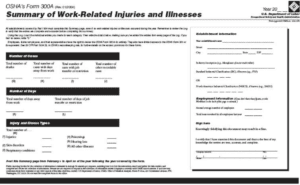Avoid These OSHA Recordkeeping Errors

Here, in no particular order, is my personal list of the ten most common mistakes found on OSHA Injury and Illness Recordkeeping forms when I perform records reviews for clients:
- No case number appears on the Form 300 and Form 301. See column A of the Form 300? This is where you have to enter a case number, which is a unique number (e.g.: 01, 02, 03 . . .) that you assign to each recordable incident. But be aware that this case number must ALSO appear on the corresponding OSHA Form 301 (Injury and Illness Incident Report) on line 10. And if you utilize an “equivalent” form in lieu of the OSHA 301 (such as a workers comp first report of injury form), this case number must appear somewhere on the alternate form as well.
- Check-marks are entered in both Column “H” (days away from work) AND Column “I” (job transfer or restriction) under the “Classify the Case” section of the OSHA 300. I see this happen often whenever an employee has to stay off work for a few days due to their injury, and then comes back to work on light duty for a couple of days. It seems logical that you would check both columns, right? However, the proper procedure in this case would be to check only one of the two boxes (the one with the most severe classification, which in this case is “days away from work”). The reason you do not check both is that at the end of the year when you tally up the final numbers, you would actually show two incidents instead of one, and your incident rate would be artificially high.
- The employer does not enter both the number of days away from work (in Column K) AND number of days with job transfer or restriction (in Column L) of the OSHA Form 300 when an employee has both. This is the contrasting problem to the previous listed problem. Even though you would only check Column K under “Classify the Case” in the example above, you would still list the corresponding number of lost workdays AND days with job transfer or restrictions. So remember, in any incident involving both lost workdays and job restrictions or transfer, even though there would only be one checkmark (in column H), there would be days entered in both columns K and L.
- The employer mistakenly enters the number of scheduled work days missed or with transfers/restricted duty instead of the number of Calendar days in columns “H” and “I” of the OSHA Form 300. This is often due to the record-keeper doing things the old way, when we used to fill out the OSHA 200 form. OSHA now requires you to enter the total number of calendar days missed or on light duty in these columns, not the number of scheduled workdays missed or on light duty. So even if an employee who normally works Monday through Friday with weekends off is injured on a Friday and the doctor says he is not able to return to work or is on restricted duty until the following Monday, you would have to count the Saturday and Sunday that the doctor said they could not work as lost or restricted workdays. [Reference 1904.7(b)(3)(iv) and (v)].
- Incidents that should be recorded as an Illness are instead being classified as an Injury under Column M. If an employee suffers flash-burn from welding, would you classify that as an injury or an illness? It should actually be classified as an illness (entered in line 6, titled “All Other Illnesses”). Incidents that are cumulative in nature (such as flash-burn, sunburn, noise-induced hearing loss, and cumulative trauma disorders) are generally considered as illnesses, whereas injury incidents typically result from a single exposure or event.
- Incidents affecting temporary service employees working under contract for an employer are not entered on that employer’s OSHA injury and illness records. The OSHA standards require you to enter all recordable incidents on your log suffered by any employee if you are directing their day-to-day activities. That is typically (although not always) the case where a company contracts with a temporary help service or employee leasing company; the exception being when the temp service or leasing agency is also supervising the actual work being performed by their workers. [Reference 1904.31(b)(2)]
- Recordable injuries or illnesses are not entered on the OSHA Form 300 within seven (7) calendar days of notification about the incident occurring, as required by OSHA. Typically, employers know about such incidents on the day they occur, and that is when the seven day calendar day count begins to record the incident on your OSHA Form 300 (Log of Work-related Injuries and Illnesses). But in those cases where the employer does not learn about a recordable incident until a few days after it occurs, the seven days begins on the day they find out about it happening. So do not wait and update your logs once a month (or even once a quarter), as I so often see. Keep them up-to-date to within one week. [Reference 1904.29(b)(3)]
- Employers often under-report the “total hours worked by all employees last year” on the OSHA Form 300-A (Summary of Work-Related Injuries and Illnesses). The total hours worked by all employees at the establishment during the corresponding year must be recorded on the form (see the right-hand side of form, under establishment information). This is important because under-reporting your hours worked will make your incident rates artificially high! Under-reporting is usually due to the employer forgetting to count the hours worked for ALL employees working at the establishment; this includes not just workers on the line, but also all salaried positions such as supervisors and managers, employees in support functions such as engineering, accounting, purchasing or human resources, and even the Big Kahuna himself (or herself). If they work at that site and are injured, that incident would go on your log, so you get to count their hours worked too. [Reference 1904.32(b)(2)(ii)]
- The signature certifying the accuracy of data on the OSHA Form 300-A is not that of a “Company Executive”. If you are the site safety manager, HR manager, or office manager, you most likely do not meet the definition of a company executive, and therefore should not be signing this particular form. OSHA defines an executive as the company owner (if the company is a sole proprietorship or partnership), a corporate officer, the highest ranking company official working at that site, or the immediate supervisor of the highest ranking person at the site. [Reference 1904.32(b)(4)]
- An employer does not maintain OSHA Injury and Illness Recordkeeping Forms for their company because they mistakenly claim the “small employer” exemption. Okay, this one is not actually addressing a mistake on a form; it addresses people who mistakenly think they don’t have to fill out the forms. The OSHA standards say that an employer is generally exempt from maintaining these forms IF their company had ten (10) or fewer employees all of the previous year. There are two operative terms here; the first one is “ALL”, as in “all” of the previous year. You must look at your peak employment number throughout the entire year, and if that number was more than ten at any time during the previous year, then you must keep the forms the following year. Also, keep in mind that this is saying the total number of employees working for the COMPANY; you may employee fewer than ten employees at your particular site, but if there are other establishments within the same company (for example, a manufacturer with multiple facilities located throughout the state), you must count the total number of all COMPANY employees to see whether or not you qualify for that small employer exemption, not just the ones at your particular facility. [Reference 1904.1(b)(1) and (2)]
That is my personal list of mistakes I find most often when reviewing the OSHA injury and illness records of clients. While you may consider some of these findings “ticky-tacky”, they are all citable offenses none-the-less, and you don’t want to give an OSHA compliance officer any reason to pull out his or her pen. And in a couple of these cases, the mistakes could actually result in a higher than necessary incident rate for your establishment, which could have very negative ramifications. So take a few minutes to check your OSHA injury and injury recordkeeping forms for the last five years (that is how long you are required to maintain them) and fix any mistakes you may find. And please scroll down to share your thoughts with us in the “Comments” section of this post.
Please pass a link to this blog post along to others in your network who you think may benefit from this information. Thanks – Curtis

